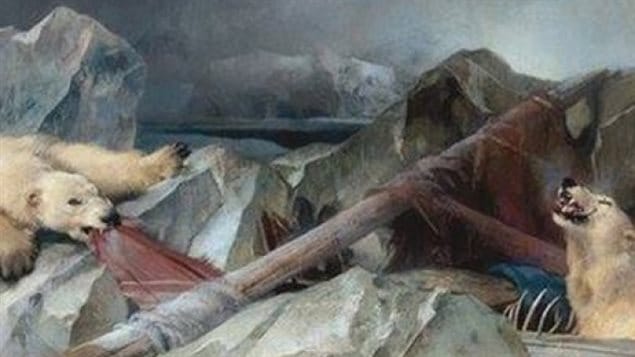Unveiled at the Glenbow museum this week, the painting is a replica of a grisly work that hangs in London’s Royal Holloway College.
It relates to the lost Franklin expedition of 1845 to find the fabled Northwest Passage through the Arctic seas.
The painting is part of an exhibit at the Calgary Alberta museum called “Vanishing Ice; Alpine and Polar Landscapes in Art 1775 – 2012″
The original is said to be cursed, and that if the college students look at it too long while sitting exams, they will fail. A rumour has it that sometime in the 1980’s it drove one student mad, who later committed suicide.
The recent discovery of the sunken wreck of one of Franklin’s ship, lost for over 160 years, has renewed interest in the mysterious failed Arctic mission and the crew.
The idea that two large well-prepared ships and that most of the full crew of over 100 simply disappeared came as shock to Britain in the mid 1800’s. Search and rescue ships came back from the Arctic empty-handed at first, increasing the mystery, but almost 10 years later, another search mission returned with Inuit tales of cannibalism among the half-frozen crew. British Victorian society was horrified and in complete disbelief and denial.
In 1864, English artist Edwin Landseer painted his image of polar bears tearing at the wreckage of a ship and gnawing on human bones.
The work is called, Man proposes, God disposes.
It depicts polar bears tearing at the remains of the ship and gnawing on human bones.
In part, it helped to assuage Victoria senses about cannibalism, but also
Went some way to dispel that same Victorian attitude of invincibility that all that British planning and pluck, sometimes failed against the brutal forces of nature.
It’s not sure why Thomas Holloway bought the painting (at an extremely high price) for his Women’s College at the time. It was not the sentimental image deemed suitable for genteel young women of the period. It is thought perhaps he wanted to deliberately provoke discussion in young minds about the forces of nature and those of a civilized society.
However, the rumours about the painting and failing exams seems to have started somewhere back between the 1920’s to 1940’s according to the University of London curator. The legend about the mad student and suicide, though widespread, appears to have no factual basis.
However, since about the 1970’s a tradition was established to cover the original with the British Union flag during examinations.
The Glenbow exhibit is on until January 4th, 2015







For reasons beyond our control, and for an undetermined period of time, our comment section is now closed. However, our social networks remain open to your contributions.